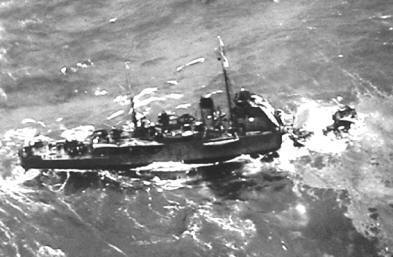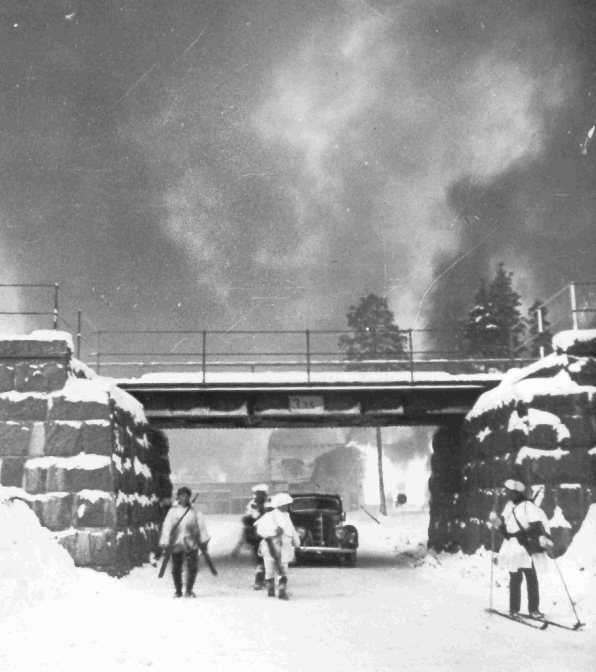Friday 8 March 1940
 |
| A repair worker being pulled out of the barrage balloon she is fixing as part of her duties with the Women's Royal Auxiliary Air Force (WAAF), 8 March 1940. |
Finnish Marshal Carl Mannerheim, who was against the war, sees the military situation deteriorating presses for the government to accept the offer of assistance from the Allies. Foreign Minister Väinö Tanner feels this will sabotage the negotiations proceeding in Moscow.
The Soviets reject a Finnish request for an immediate cease-fire while negotiations proceed.
The Finns in the bay capture more islands in Viipurinlahti Bay.
The T-Line is holding, but barely. The Soviet 7th and 13 Armies continue assaulting it.
Further north, at Kuhmo, some remaining elements of the Soviet 54th Rifle Division of the 9th Army that has been trapped in a dwindling pocket are eliminated by the Finns.
Winter War Peace Talks: Finnish Prime Minister Risto Ryti and his team meet with the Soviet negotiators at 16:00. Molotov heads the Soviet delegation, and other members are Chairman of the RSFSR Supreme Soviet Andrei Zhdanov and General A. M. Vasilevski. Stalin himself does not get involved.
Battle of the Atlantic: British 5,068-ton freighter Counsellor (Master Harold Coates) hits a mine and sinks near Liverpool. The mine was laid by U-30 on 6 January 1940. All 78 onboard survive. The ship is the command ship of the convoy's commodore, Rear Admiral H.G.C. Franklin, RN. A destroyer tried to take it in tow, but it ultimately sank.
The mines laid by U-30 have had a tremendous return, as they now have claimed 6 ships totaling 33,000 tons.
German 5,600 ton freighter Hannover is set on fire by its crew rather than allow its capture by Canadian destroyer HMCS Assiniboine in the Mona Passage off the Dominican Republic. The crew then abandons the ship, which does not sink. Later, a boarding party from British light cruiser HMS Dunedin salvages the ship. Two other German freighters, Mimi Horn and the Seattle, slip by while the British are occupied and head north.
British submarine HMS Tarpon (Lt. Commander Herbert J. Caldwell) is commissioned.
Convoy OA 106 departs from Southend, Convoy OB 106 departs from Liverpool.
European Air Operations: Luftwaffe Heinkel He 111s attack fishing trawlers and any other ships that they can spot. Along the British east coast. An RAF reconnaissance goes all the way to Poznan, (occupied) Poland, to drop leaflets, the farthest of the war to date. A Heinkel goes down in the north sea.
German/Italian Relations: One of the lesser-known features of the war is Hitler's correspondence with other leaders. Today, he corresponds with Mussolini, who he wants to join the German war effort, in a sort of chatty way.
German/Norwegian Relations: The Finnish government lodges a secret (or at least not publicized) diplomatic protest with the Germans over the sinking of Norwegian sinks.
British Government: Perhaps to allay public fears, the government releases information about the countermeasures it has developed to magnetic mines.
Soviet Military: It is "International Women's Day" in the Soviet Union. Female soldiers are decorated for valor, and there are dance performances and related events in army units arranged by the "sisters of struggle" women's groups attached to them.
Soviet Government: Following on from the 7 March 1940 Politburo decision to execute the Polish officers, their relatives now are condemned as "enemies of the state" and are slated to be sent to Siberia.
US Government: Sumner Welles continues his meetings in Paris. Today, he meets with Jules Jeanneney and Édouard Herriot, who are not interested in negotiating with Germany.
Holocaust: German police order all Jews in Lodz to move to the ghetto immediately. Anyone resisting such orders is shot. According to Irena Liebman, a Jewish resident of Lodz: "Starting this morning more & more people filled the streets with knapsacks, suitcases, bundles." It is a "caravan of poverty."
Future History: Susan Clark is born in Sarnia, Ontario, Canada. She becomes famous in the 1960s for such films as "Coogan's Bluff" with Clint Eastwood, and later for television shows such as "Webster."
 |
| The Counsellor sinks on 8 March 1940 (Photo from City of Vancouver Archives, CVA 447-2130). |
March 1940
March 1, 1940: Soviet Breakthroughs Past ViipuriMarch 2, 1940: Soviets Swarm West in Finland
March 3, 1940: Soviets Across Gulf of Viipuri
March 4, 1940: USSR Apologizes to Sweden
March 5, 1940: Katyn Forest Massacre Approved
March 6, 1940: Finns Head to Moscow
March 7, 1940: The Coal Ships Affair
March 8, 1940: Peace Talks Begin in Moscow
March 9, 1940: Soviets Harden Peace Terms
March 10, 1940: Germany Draws Closer to Italy
March 11, 1940: Winter War Peace Terms Finalized
March 12, 1940: War is Over (If You Want It)
March 13, 1940: Winter War Ends
March 14, 1940: Evacuating Karelia
March 15, 1940: The Bletchley Bombe
March 16, 1940: First British Civilian Killed
March 17, 1940: Enter Dr. Todt
March 18, 1940: Mussolini To Join the War
March 19, 1940: Daladier Resigns
March 20, 1940: Soviets Occupy Hango Naval Base
March 21, 1940: Paul Reynaud Leads France
March 22, 1940: Night Fighters Arise!
March 24, 1940: French Consider Alternatives
March 25, 1940: Reynaud Proposes Action
March 26, 1940: C-46 First Flight
March 27, 1940: Himmler Authorizes Auschwitz Construction
March 28, 1940: Allies Ponder Invading Norway
March 29, 1940: Soviets Prefer Neutrality
March 30, 1940: Allied Uncertainty
March 31, 1940: The Tiger Cage
2019











